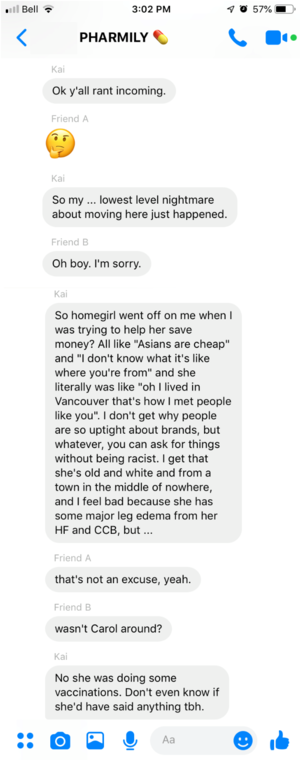In groups of 3-4:
1. Read the case study and consider your response to the Essential Question(s) posed below.
2. Discuss each question below with your group, using the linked resources to support your responses.
3. Take notes on your discussion to share when the large group reconvenes.
- Professional and personal boundaries
- Interconnectedness of small communities
- Patient trust
- Off-duty professionalism
By the end of this workshop and upon further reflection, students will ...
- Identify key professional resources for guiding online behaviour
- Describe how accountability operates in the context of private messaging
- Discuss the tension that can arise between one's personal values and those of the profession
As you read the case, consider your response to the question:
How have online platforms impacted in-person communities?

Kai has recently begun their 8-week pharmacy practicum at an outpatient pharmacy in a small town in inland BC.
Coming from Vancouver, they are a bit apprehensive about the placement, and feel a little lonely and isolated.
Upon starting their degree, Kai set up a Facebook account for group work and event organizing. They have a group chat with some friends from their graduating class. They use this group chat to stay connected to their friends, which has helped make their stay in this small town a bit less lonely. There is an unspoken assumption that this group chat is a safe space to talk about their work lives, especially now that they are all doing their third year practicums.
Everyone is well aware of the higher social standards to which pharmacists are held, and this is their way of keeping any venting out of public posts on their social media accounts. They are aware of the onus put on pharmacists to maintain society's trust in the profession and have been taking steps to separate their professional and personal life.
A few weeks into their practicum, Kai encounters one of the pharmacy's regular patients named Susan, who is picking up a refill for a calcium channel blocker.
Susan has lived in this community almost all her life, except for a brief interim when she moved to Vancouver about 20 years ago to work in various jobs. That is where Susan first met, in her words, "people like you." She moved back about seven years ago because she didn't like the high costs of living in the city. Kai learns all of this while accessing Susan's patient file in the pharmacy system and obtaining her medical history.
The refill is for Norvasc, which is a branded medication. When Kai inputs the prescription, the system automatically switches it to the generic, amlodipine.
Kai confirms the refill with Susan, reading it out loud. Susan takes exception and says that the doctor said the name 'Norvasc' to her.
Whilst Kai is explaining that the generic is cheaper and essentially no different from Norvasc, Susan interrupts to insist on talking to "the actual pharmacist." However, the pharmacy is pretty busy, and Kai's Practice Educator is currently occupied with giving someone else a set of travel vaccinations.
Apologizing, Kai tries to explain again that the generic has the same active ingredient as the brand name drug, and that manufacturers must prove that they are equal in efficacy and safety, but Susan starts getting loud and says: "Of course, I should have expected you to be cheap."
As there is a line forming at the pharmacy counter, Kai remains calm and professional, telling Susan that she can have the Norvasc and that there was no intention of cheating of any sort. Kai puts a note on file that Susan prefers brand, and passes the refill along to the filling counter. Susan walks off, muttering something about "who does this kid think he is" to the next person in line.
During a quiet moment towards the end of his shift, Kai retells this encounter in the Facebook group chat.

Unbeknownst to Kai, another friend in the group chat knows someone in the town. This friend, Kyla, screenshots the chat and sends it to her friend, when talking to them about what living in a small, rural community is like. After learning that edema means swelling, given the small population size and description of the patient, Kyla's friend knows exactly who Kai is talking about.
With good intentions, this friend-of-a-friend tries talking to people they know about making Kai feel more welcome in the community.
Being a small town, the news of the incident makes its way around to Kai's Practice Educator, Carol, pretty quickly.
Carol says to Kai "Hey, so I heard something upsetting happened to you recently here? Something to do with Susan?" and tried encouraging Kai by saying, "I want you to feel supported here. Do you want me to reach out to the university's Office of Experiential Education?"
However, Kai is both taken aback by Carol's knowledge of the situation, and unsure how to respond. Kai feels pretty justified in their emotional response to the situation and wasn't expecting the Practice Educator to find out about what happened, or to know the patient involved. Kai doesn’t know how the Practice Educator found out: did Carol see the actual chat or did she hear about it from someone who was in the pharmacy at the same time?
Now, Kai is worried about their job future, how they will be perceived professionally, and if they have violated the patient's privacy.
- What key professional resources outline guidelines for appropriate use of social media? How could such resources have been used to guide Kai's actions in the scenario described above?
- How does accountability apply to private group chats? How did issues surrounding accountability emerge in the scenario described above?
- HIPAA Social Media Rules (Report)
- How has social media impacted the tensions that can arise between one's personal values and those of the profession? List potential ways in which social media has both positively and negatively impacted this relationship.
- ASHP Statement on Use of Social Media by Pharmacy Professionals (Journal Article)
- Ethical Issues of Social Media Usage in Healthcare (Journal Article)
- Guidelines for Using Electronic and Social Media: The Regulatory Perspective (Journal Article)
|
When re-using this resource, please attribute as follows: developed by the University of British Columbia: Digital Tattoo – Case Studies Project Team.
Post image: Group texting by terimakasih0 (Pixabay License)